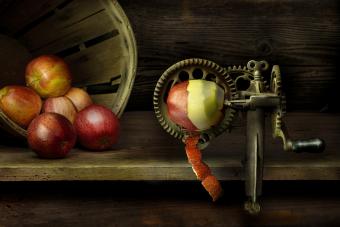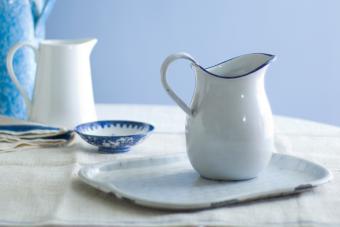
Although they're meant to hold pocket change, vintage piggy banks can be worth some serious money. These old banks have a totally fascinating history, and there are a few factors that can determine which are worth the most and which are just cute knick-knacks to decorate your shelves. If you're out thrifting, there are some signs that you might want to give that piggy bank a second look, because it just might be a chance to bring home the bacon.
Really Old Piggy Banks

Money boxes with slots have been around for centuries, and the familiar pig shape is actually nothing new. The oldest piggy banks probably date to the 16th century. They were made of terracotta clay, sometimes called "pygg." Some historians believe the name "piggy bank" may come from the name of the clay.
No matter where the name comes from, one thing's for certain: you had to break the bank to get your money out. This means there aren't very many of these super old banks still in existence (people did want their money back, after all). Even very tiny examples can be worth something, such as one three-inch-long piggy bank from the 1800s that sold for about $55.
Vintage 1940s Piggy Banks

Coming just after the Great Depression when many people lost trust in traditional banks, the 1940s was the golden age of the piggy bank. You'll see some with pigs dressed in suits and ties or representing politicians, and these can be among the most valuable. One cast iron piggy bank from the 1940s with an upright pig dressed in a suit sold for about $800. If you have a formally dressed pig, it's worth checking out in more detail.
Extra-Large Banks in the Shape of Pigs

Most piggy banks are a few inches long, but super large hogs are worth more - sometimes a lot more. Any large bank, whether it was made in the 1880s, 1980s, or sometime in between, should get a second glance. One mid-century example that was 22 inches long and wearing green overalls sold for over $300.
Vintage Corningware Piggy Banks

Vintage Corningware tends to be valuable, sometimes really valuable, and piggy banks made by the company are definitely no exception. They regularly sell for $150 or more, especially if they are in coveted patterns like Cornflower Blue or Spice O'Life. One Corningware piggy bank in Cornflower Blue sold for almost $200.
Mid-Century Clear Glass Piggy Banks

Mid-century clear glass piggy banks can be worth a surprising amount of money, sometimes hundreds of dollars. These simple clear glass containers have screw lids or corks, and they're made by companies like Libbey and Anchor Hocking. They aren't all super valuable, but the Libbey This Little Piggy Went to Market bank is especially coveted by collectors, selling for about $200.
Cast Iron Banks in Pig Shapes

Just as cast iron doorstops are super collectible, there's a hot market for cast iron banks in general. There are still banks (like piggy banks) and moving banks where you put a coin in and something happens. Although the moving banks are usually worth the most, piggy banks can be worth a pretty penny. Look for examples with glass eyes in particular. One cast iron piggy bank with glass eyes sold for about $150.
Chalkware Piggy Banks

Chalkware was an inexpensive and popular material for making figurines during the mid-20th century, and chalkware piggy banks can be especially valuable because they're hard to find in good condition. The soft material tended to crack and chip easily, and these banks were prone to breakage. If you have one, especially an example with hand-painted details, it could be valuable. One from the 1960s sold for about $150.
Sign up for our newsletter featuring all the latest stories and products we love.
Mid-Century Art Pottery Piggy Banks

You might not expect it when you look at a piggy bank, but mid-century art pottery is a serious focus for collectors. Pieces by famous names like Hull, Roseville, and McCoy can fetch top dollar. One Hull piggy bank sold for about $100, and it's not uncommon for them to sell in the $50 to $150 range.
Pause to Identify Vintage Piggy Banks Worth Money

If you have an old 1960s piggy bank or one from the pre-WWII era, you might have real money on your hands. Rare piggy banks by glass companies and potteries can also be especially valuable, as can anything unusual (pigs in suits, overalls, and other strange clothing). Pause before donating an old piggy bank to charity or selling it at a garage sale and make sure you're not holding a treasure that could leave you living high on the hog.
Can't get enough piggy banks? Mechanical antique coin banks are super cool, highly collectible, and can be valuable.







